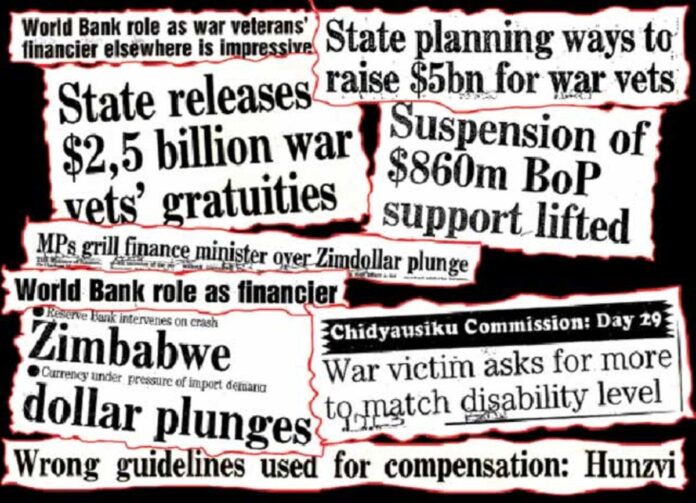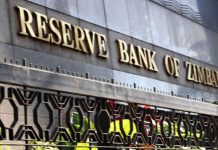Money and structural adjustment: The post-colonial economy and the question of sovereignty
Tinashe Nyamunda
Within a decade of attaining independence, things began to fall apart within the Zimbabwean economy. Despite the promise the country appeared to have, it had run a huge budget deficit financed through public debt and experienced recurrent Balance of Payment (BOP) deficits. This was despite the promise many thought it had, and despite aid raised to steer the country on a trajectory towards progress.
While Zimbabwe raised money at the Zimbabwe Conference for Reconstruction and Development (ZIMCORD), the planning towards the economy was highly problematic. What is clear is how the state lacked the imagination to find an alternative development path not tied to neo-liberal frameworks of economic management. But as the economy contracted in the late 1980s, they were forced to take recourse to drawing on World Bank and International Monetary Funds to settle debt. Just as preconditions for securing such funds had been set by them, so too had access to that money. Ironically, even as the government of Zimbabwe reiterated its political sovereignty, economically, it remained dependent on an international economy informed by global north interests.
Back to the beginning: Structural adjustment neo-colonial currency
Like Zimbabwe, many other African countries had secured money from the two Bretton Woods financial institutions. But none of them had received it without specific conditions attached to the loans. To be eligible, the borrowing countries needed to implement a programme that the IMF and World Bank incorrectly insisted would help return those countries’ economies on a path of growth and development. In a book entitled The Economic Structural Adjustment Programme: The Case of Zimbabwe 1990-1995, Economic Historian Alois Mlambo examines the reform package that included, not just the loan amounts Zimbabwe qualified for, but the conditions it had to first meet. This article will examine currency and economic issues in the context of the IMF/World Bank reform package and its long term implications.
I am reminded of Kenyan novelist and post-colonial theorist Ngugi Wa Thiong’o’s Decolonising the Mind: The Politics of Language in African Literature. Although Wa Thiongo’s focus was on language, there are important parallels to draw with economic decolonization. The attainment of political independence did not usher in economic sovereignty. But as the previous article demonstrated in the case of Zimbabwe, the colonial economic structure remained intact. The economic management strategy was informed by United Nations System of National Accounting (SNA) frameworks designed as a pre-requisite for countries needing access to IMF loans.
However national economic planning came to be anchored around access to debt. In this context, access to finance had become dependent upon global north processes, not least the value of the local currency itself which became subject to connections in the international exchange system. This made Zimbabwe particularly vulnerable economically to Euro-American designs. The planners of the 1980s and 1990s never took heed of the work of academics who insisted that retaining such ties would be problematic. This resulted in a kind of Zimbabwe’s reconciliation with Rhodesia and the country came to epitomize a revolution that lost its way. The economic thinking of the country’s technocrats, much like Wa Thiongo decried, requires even to date, decolonization despite their claims to represent a revolutionary party.
The collapse in the Zimbabwean economy, compounded as it was by declining productive capacity and deepening corruption, was only kept in check by Rhodesian era exchange controls that were retained until 1990. But in the face financial scandals, even they would not be able to delay the inevitable turn towards Bretton Woods intervention. The Minister of Finance at the time, Bernard Chidzero held a strategic position at these institutions. Not only had he worked for UN agencies such as the United Nations Economic Commission for Africa (UNEC) and the United Nations Commission for Trade and Development (UNCTAD), but he lost only to Boutros Boutros-Ghali for the position of UN Secretary-general in 1992. His firm belief in the work of these organisations was unquestionable. So it is unsurprising that he forcefully pushed for securing loans from the IMF and World Bank despite local skepticism.
Robert Mugabe had earlier held that he would not take any loans from multi-lateral lending institutions that came with strings attached. But just as with ZIMCORD at independence, Chidzero saw Zimbabwe’s economic salvation coming from these multilateral loans and had not, even ten years later, accepted that this would only worsen debt.
ESAP and the neo-liberal turn in Zimbabwe: Whose currency was it really?
In his book on the impact of the Economic Structural Adjustment Programme (ESAP) in Zimbabwe, Mlambo convincingly demonstrates the ways in which this policy did far more harm than good for the Zimbabwean economy. He also noted a number of examples in the cases of Sudan, Egypt and Tanzania where ESAP programmes had been disastrous. In fact, Mlambo suggests that this should have been considered by policy makers before they adopted the programme. The ways in which the institutions worked up to that point were as follows: If a country wants to borrow money to finance its deficits, it would not just get it without meeting certain conditions. The IMF designed a programme to be followed by these countries, ostensibly to ensure that the funds would help to effectively turn the economy around. At least this was the impression that was given to borrowing countries. The countries were required to implement a programme of economic structural adjustment.
The conditions were two fold. Firstly, the countries were supposed to restructure their economies in ways that made more efficient. To fulfill this requirement, they were expected to separate the roles of the state from that of the market or the economy. In the context of Zimbabwe, where the independence dispensation did not bring about anticipated radical economic transformation, the government appeased its base by putting a number of subsidies in place to supply affordable education, health care, subsidies for transportation and basic commodities, among others. To facilitate this, they utilized parastatals and funds borrowed funds and aid. This was diagnosed by the IMF as the first problem. The argument was that the government needed to stop funding these subsidies. That was how restructuring in the context of governance was suggested. But before examining the second aspect, which was adjustment, we must also appreciate the ideological context of these policies. Although the cold war was in decline in the 1990s, these kinds of policies had an element of anti-communism inherent in them and Zimbabwe was therefore forced to abandon any pretenses of the 1980s socialist experiment by accepting these conditions.
The adjustment element required liberalizing trade by suspending stringent exchange control and opening up the economy. There were a number of policies that needed to be implemented as the funds were being released at various stages. Among the most critical of these changes was the removal of exchange controls and opening up the economy. In the article on the Rhodesian UDI, an important ingredient for Rhodesian monetary stability and economic success was the application of strongly managed exchange controls.
The IMF insisted on doing the opposite. Their argument was that opening up the economy would result in the country becoming more competitive. Apparently it was supposed to increase trade and attract investment. However liberalisation of trade leads to a progressive de-nationalisation of the borrowing country’s economy through destroying locally-owned enterprises and promoting multi-national businesses. This is because liberalisation results in the flooding of the local market by cheaper imported goods which ultimately destroy local businesses whose prosperity depends on the availability of a protected local market’.
Not only did major local industries ultimately collapse and many people lost their jobs under this programme, but adopting ESAP triggered an economic trajectory that would result in the country becoming the supermarket economy that it is today; highly dependent on imports. From one of the most industrialised countries in the region to 1990, Zimbabwe has become almost entirely dependent on imports of basic manufactures from South Africa, China and elsewhere today.
Adjustment also directly affected currency value. The IMF advised the country to devalue its currency, arguing that this would improve its competitive edge by making its exports cheaper. While exports did become cheaper for the international market in which the global north predominantly benefited, the opening up of the economy did not overturn the BOP in Zimbabwe’s favour. If anything, the economy contracted even further and many people lost their jobs as such industries as textiles and other manufacturers failed to compete with cheap imports.
The parastatals were also forced to downsize although the advice had actually been to privatize. The situation became increasingly untenable to the extent that the ESAP acronym acquired a new local moniker: “Ende Satan Ari Pano [surely Satan is here]” These set of policies became so detested by the public whose material conditions continued to worsen. In the end, even the Zimbabwe dollar currency that had been adopted as a sign of economic sovereignty was exposed for the direct dependency it had on international forces. In fact, the local currency was nothing but a representation of international economic configurations in Zimbabwe which local financial authorities had little control over.
In the end, as the currency was increasingly devalued under ESAP policies, so too were people’s standards of living and the economy shrank even further. The local centre lost whatever loose grip they had on the economy especially as they continued failing to re-imagine alternative ways of regaining control.
In the end, the Zimbabwean economy that had been inherited at independence with a legacy debt of some US$700 million at independence had imploded even further. By 1991, the debt had increased to US$2 billion. In 1992, debt had increased to US$4 billion and by 1995, when ESAP was supposed to have been completed, it was well over US$5 billion. To date, Zimbabwe owes over US$11 billion dollars internationally.
As the economy collapsed, in the place of sound economic management – whatever that can be taken to mean – was increased political tolerance for graft. As ordinary people’s patience for ZANU PF promises waned and dissent increased, the ruling party fell back on patronage politics to secure its power. The veil of democracy was increasingly lifted and the government became more repressive and corrupt. All of this was not lost on the citizenry. Social commentators protest music pointed to this. Thomas Mapfumo’s Corruption and even Leornard Zhakata’s Mugove were all important commentaries of this period. They captured, in many ways, the developments arising out of the negative economic impact of ESAP and the political disconnect it caused between the ordinary people and a government that increasingly monopolised the country’s resources for its patronage machine and revealed its underlying authoritarian nature that had been limited to those who had suffered under its Gukurahundi massacres in the 1980s.
Zimbabwe Programme for Economic and Social Transformation (ZIMPREST) and the plunge into crisis
ESAP was scheduled for five years. But its impact was largely negative, leaving the country worse off economically than it had been since independence. But the government was unwilling to admit its failure because of the political reverberations this had. Ultimately, policy makers argued that the benefits of ESAP were yet to be realized and more time was required for its benefits to begin to show. But the government was also fully aware about the message that the neo liberal policy was sending. So they decided to come up with a follow up policy that claimed to address the demands for economic and social transformation. Despite its name, the policy did anything but. If it transformed anything, it was people’s material circumstances for the worst.
In the second half of the 1990s, there was increasing dissent against the government. There were protests between 1997 and 1999 against the government as unemployment worsened and all the social and welfare benefits of the 1980s were eroded. Workers protested through strikes, mass stay-aways and strikes against declining wages, students protested against the slow pace of transformation. The government’s answer to these protests was violent repression.
As the government increasingly turned towards state securitization, it decided to pay off war veterans to try and silence them and attract them to fight for their cause while retaining liberation credentials to rule. The war veterans pay offs, compounded by the country’s involvement in the Democratic Republic of the Congo civil war resulted in Zimbabwe’s economic plunge.
The economy collapsed by 74 percent on what has been termed Black Friday on 14 November 1997. Thereafter, the decline of the Zimbabwean currency continued into hyperinflation by 2009 when the Zimbabwean dollar was finally demonetized. But whatever policies the government attempted to follow at this time, including the shift towards land reform in the 2000 could not turn the Zimbabwean economy around. More people began to seek a political alternative especially in the Movement for Democratic Change (MDC) that was formed in 1999, hoping that the new opposition party would not only resuscitate the economy, but also lead a real programme of economic and social transformation.
Conclusion
The shift towards neo-liberal policies with the adoption of ESAP in the 1990s secured the postcolonial integration of Zimbabwe into the orbit of multi-lateral finance economy. It resulted in the delaying of the agenda of economic and social transformation and subjected the country’s economy to external competition, leading to its collapse. The currency, which was effectively a function of Zimbabwe’s performance on the international market was forced to devalue, and like other currencies in the region, became increasingly unstable. What is clear from these experiences is that Zimbabwe never managed to secure the economy for the majority of the people and the situation became increasingly untenable throughout the 1990s, forcing the Mugabe regime with its hunger for power to reveal its authoritarian nature. By the end of the 1990s, the Zimbabwe dollar was weak, the economy had collapsed and the government had become desperate, a situation that would plunge into a crisis in the 2000s and characterize Zimbabwe’s worsening situation to date.












Very good article… as usual Prof. So is there a way out of resuscitating the economy without borrowing from IMF etc???? Cuz conditions are still there, and when assessed one would think the conditions are to benefit the country, but after reading this, looks like things are not what they may seem
what a stubborn article. there was a period of indipenence from Brittain under white minority rule. then a power sharing government was established between white and black for a reason. the example of every former african colony going to majority rule showed the countries economically collapsed, sometimes violently under so called indipendence. I think the histroy books show almost 100% corrupt dictatorships after so called colonial liberation. If you had an honest mind you would note marxism was not about freedom and all so called black movements wanted a marxist dictatorship/government. the whites were not colonials. all of my family ancestors had settled for a minimum 3 generations and were settlers in 3 countries in southern africa. prior to rhodesia becoming zimbabwe there was global sanctions and war yet the economy collapsed when the country became zimbabwe. you cant admit that introducing marxism and dictatorship caused the collapse and you obviously supported it. its your fault.if people like you had of supported the power sharing government it would possibly be one of the wealthiest contries in the world. anyway. you arent too bright. you are biased racist and fter 40 years zimbabwe is a dump. because most of the white population ran away. ive read half of the black population have run away from the poverty. if only people like you had negotiated a new government. but no, now you want to blame white people for the world economic forums plan all along. impoverish rhodesia,zimbabwe. its going to continue and get worse under imaginary corona virus.